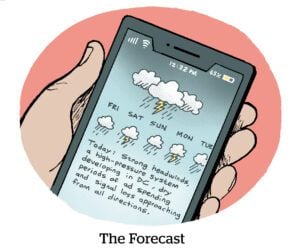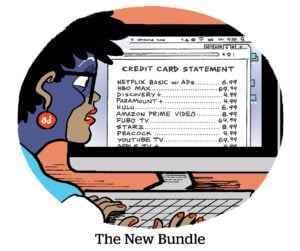Here’s today’s AdExchanger.com news round-up… Want it by email? Sign up here.
Can You Hear Me Now?
Consumers wary about targeted ads are convinced their devices are eavesdropping on their conversations. Most marketers insist that’s not the case, and their use of other targeting signals has gotten so sophisticated that it just feels like your devices are listening.
However, Cox Media Group, which owns and operates TV and radio stations across the US, is outright admitting that – yep – it’s listening to users through their smart devices, 404 Media reports.
In a recent marketing pitch, CMG highlighted its “Active Listening” capability that accesses microphones in smartphones, connected TVs, smart speakers and other devices to listen in on conversations for advertising purposes. This appears to be the first time a marketing team has not only admitted to the practice but is actually using it as a selling point.
Clients can set a geolocation for Active Listening, and an AI parses the conversations captured for targeting signals. CMG’s marketers then use those signals to serve ads on streaming TV and audio, display networks, YouTube, and Google and Bing search.
CMG’s website claims the practice is perfectly legal because users provide consent when accepting terms and conditions for software updates. But the company took down the part of the website pitching the product after the story came out and declined to comment to the reporter who wrote it.
One marketer who heard the pitch told 404 Media they immediately ditched their Amazon Echo speakers and disabled microphone access on their own devices.
Fourth Time’s The Charm
Google Ads told customers last week that it will support enhanced conversions for Google Analytics 4 in the next few weeks. (H/t @Mike Ryan of the ecommerce consultancy SmarterCommerce.)
That news won’t make waves, but it’s notable.
For one thing, Google Ads and Google Analytics are being rationalized – at last. Advertisers and publishers are often surprised to discover that Google Analytics and Google Ads have different systems for reconciling traffic and user targeting from ad campaigns.
Google account reps must constantly explain that its ad server data doesn’t match the site’s own Google Analytics tag because, well, they don’t match.
With the new GA4, they do.
But the data is being rationalized toward Google first-party data. What was formerly the Google Analytics global site tag is now simply the Google tag. The formerly standalone analytics tag was subsumed by the Google Borg.
The enhanced conversions product, which launched in 2022 as an adaptation to Apple’s anti-tracking policies, hashes and matches advertiser first-party data to Google’s identity graph. And since it touches Google’s ID data, other ad tech vendors may not be able to integrate with GA4 in the same way.
Sweet Streams Are Made Of This
Live sports are just about the only content still propping up linear TV. But traditional media companies with sports broadcasting rights are turning their attention to streaming, according to The Hollywood Reporter.
Like media companies, streamers are incorporating sports into their strategy because younger viewers aren’t really watching cable TV.
Disney’s ESPN+ has 26 million subscribers, and Hulu simulcasts a number of NHL games. Warner Bros. Discovery’s Max platform broadcasts the MLB playoffs and NBA and NHL games. And sports are also a big draw for new subscribers to Paramount+ and NBCUniversal’s Peacock.
Amazon touts its $1 billion per year Thursday Night Football deal as a source of subscriptions and advertising business, while YouTube has Sunday Night Football.
Netflix hasn’t made any moves to acquire sports rights yet, though it holds live sporting events and offers sports documentaries.
It might be wise for Netflix to hold off, given its livestream issues earlier this year. These sorts of technical glitches are also a concern for other streamers and sports leagues.
Peacock is streaming an NFL postseason game exclusively in January. We’ll see if it passes the test.
But Wait, There’s More!
As Amazon gears up to launch its Prime Video ad business, it’s hunting for a senior-level sales hire. [Business Insider]
French media company Vivendi may spin off Havas, Canal+ Group and Lagardère Group. [Adweek]
TikTok is asking advertisers to increase their spend on the platform by at least 50% next year. [The Information]
You’re Hired!
Stagwell Marketing Cloud names Elspeth Rollert as its first CEO. [Digiday]















